Related Research Articles
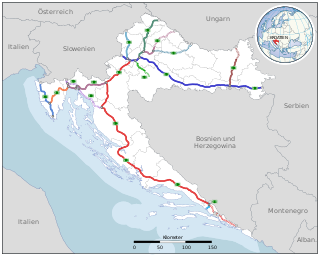
Transport in Croatia relies on several main modes, including transport by car, train, boat and plane. Road transport incorporates a comprehensive network of state, county and local routes augmented by a network of highways for long-distance travelling. Water transport can be divided into sea, based on the ports of Rijeka, Ploče, Split and Zadar, and river transport, based on Sava, Danube and, to a lesser extent, Drava. Croatia has 68 airports, nine of which are international. The country also has several airlines, of which the most notable are Croatia Airlines and Trade Air. Rail transport is fairly developed, with dual track and electrification not very common, although high-speed tilting trains are used on some routes. However, bus still tends to be more common than rail as a mode of inter-city transport.
The Trans-European road network (TERN) was defined by Council Decision 93/629/EEC of 29 October 1993, and is a project to improve the internal road infrastructure of the European Union (EU). The TERN project is one of several Trans-European Transport Networks.

The Trans-European Transport Network (TEN-T) is a planned network of roads, railways, airports and water infrastructure in the European Union. The TEN-T network is part of a wider system of Trans-European Networks (TENs), including a telecommunications network (eTEN) and a proposed energy network. The European Commission adopted the first action plans on trans-European networks in 1990.

EuroVelo is a network of currently 17 long-distance cycling routes criss-crossing Europe, in various stages of completion. When completed, the EuroVelo network's total length will almost be 90,000 km (55,923 mi). As of November 2019 more than 45,000 km (27,962 mi) were in place. EuroVelo is a project of the European Cyclists' Federation (ECF).

The modern terms short-sea shipping, marine highway, and motorways of the sea, and the more historical terms coastal trade, coastal shipping, coasting trade, and coastwise trade, all encompass the movement of cargo and passengers mainly by sea along a coast, without crossing an ocean.

The United Kingdom has a network of roads, of varied quality and capacity, totalling about 262,300 miles (422,100 km). Road distances are shown in miles or yards and UK speed limits are indicated in miles per hour (mph) or by the use of the national speed limit (NSL) symbol. Some vehicle categories have various lower maximum limits enforced by speed limiters. A unified numbering system is in place for Great Britain, whilst in Northern Ireland, there is no available explanation for the allocation of road numbers.

European route E73 forms part of the United Nations International E-road network, connecting Hungary and eastern Croatia to Bosnia and Herzegovina and the Adriatic Sea in the vicinity of the port of Ploče. This 679-kilometre (422 mi) route is also designated as the Pan-European Corridor Vc, a branch of the fifth Pan-European corridor. The route largely consists of two-lane roads with at-grade intersections, although in the 2000s, about a third of the route was upgraded to motorway standards. The remainder of the route is currently being upgraded in all the countries spanned. The longest part of this corridor goes through Bosnia and Herzegovina and is widely touted as a road instrumental to the development of the country. The road also serves as the shortest connection of the eastern and southern parts of Croatia.
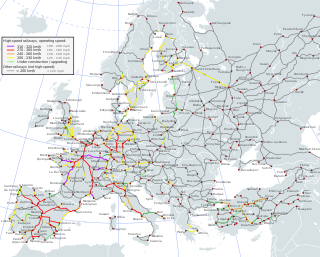
The Trans-European high-speed rail network (TEN-R), together with the Trans-European conventional rail network, make up the Trans-European Rail network, which in turn is one of a number of the European Union's Trans-European transport networks (TEN-T). It was defined by the Council Directive 96/48/EC of 23 July 1996.

Transport in the European Union is a shared competence of the Union and its member states. The European Commission includes a Commissioner for Transport, currently Adina Ioana Vălean. Since 2012, the Commission also includes a Directorate-General for Mobility and Transport which develops EU policies in the transport sector and manages funding for Trans-European Networks and technological development and innovation, worth €850 million yearly for the period 2000–2006.

Highways in Croatia are the main transport network in Croatia. The Croatian classification includes several classes of highways:

The Schengen Area is an area comprising 26 European countries that have officially abolished all passport and all other types of border control at their mutual borders. The area mostly functions as a single jurisdiction for international travel purposes, with a common visa policy. The area is named after the 1985 Schengen Agreement signed in Schengen, Luxembourg.

The Grimaldi Group is a private shipping company owned by the Grimaldi family and based in Naples, Italy. Grimaldi operates a large fleet of ro-ro, ro-ro/multipurpose, con-ro multipurpose, PCTC, ro-pax and cruise ferries vessels.
The Trans-European conventional rail network, together with the Trans-European high-speed rail network, make up the Trans-European Rail network, which in turn is one of a number of the European Union's Trans-European transport networks (TEN-T). It was defined by the Council Directive 2001/16/EC of 19 March 2001.
The Trans-European Rail network is made up of the Trans-European high-speed rail network as well as the Trans-European conventional rail network. The rail network is one of a number of the European Union's Trans-European transport networks (TEN-T).
The Trans-European Inland Waterway network is one of a number of the Trans-European Transport Networks (TEN-T) of the European Union.
The Trans-European Seaport network is one of a number of the Trans-European Transport Networks (TEN-T) of the European Union.
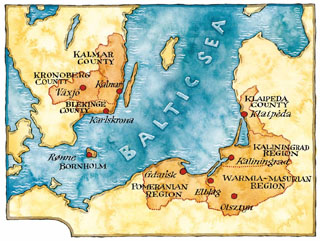
Euroregion Baltic(ERB) is an institutionalised form of cross-border cooperation in the south-east of the Baltic Sea Region, consisting of eight regions of Denmark, Lithuania, Poland, Russia, and Sweden.
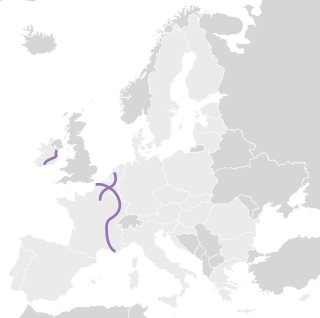
The North Sea–Mediterranean Corridor is the number 8 of the ten priority axes of the Trans-European Transport Network. It stretches from Ireland and the north of UK through the Netherlands, Belgium and Luxembourg to the Mediterranean Sea in the south of France.

Via Carpathia is a planned transnational highway network connecting Klaipėda in Lithuania with Thessaloniki in Greece. It is currently planned to open in 2025.
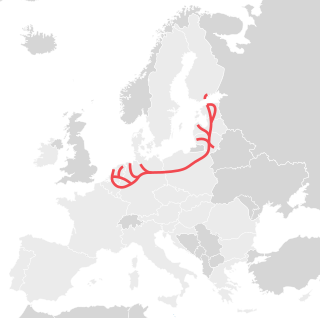
The North Sea–Baltic Corridor is the number 2 of the ten priority axes of the Trans-European Transport Network (TEN-T).
References
- ↑ White paper European transport policy for 2010: time to decide [ permanent dead link ]
- ↑ Decision No 884/2004/EC of the European Parliament and of the Council of 29 April 2004 amending Decision No 1692/96/EC on Community guidelines for the development of the trans-European transport network: Official Journal L 167, 30 April 2004 P.0001 – 0038, COM(2004)0884)